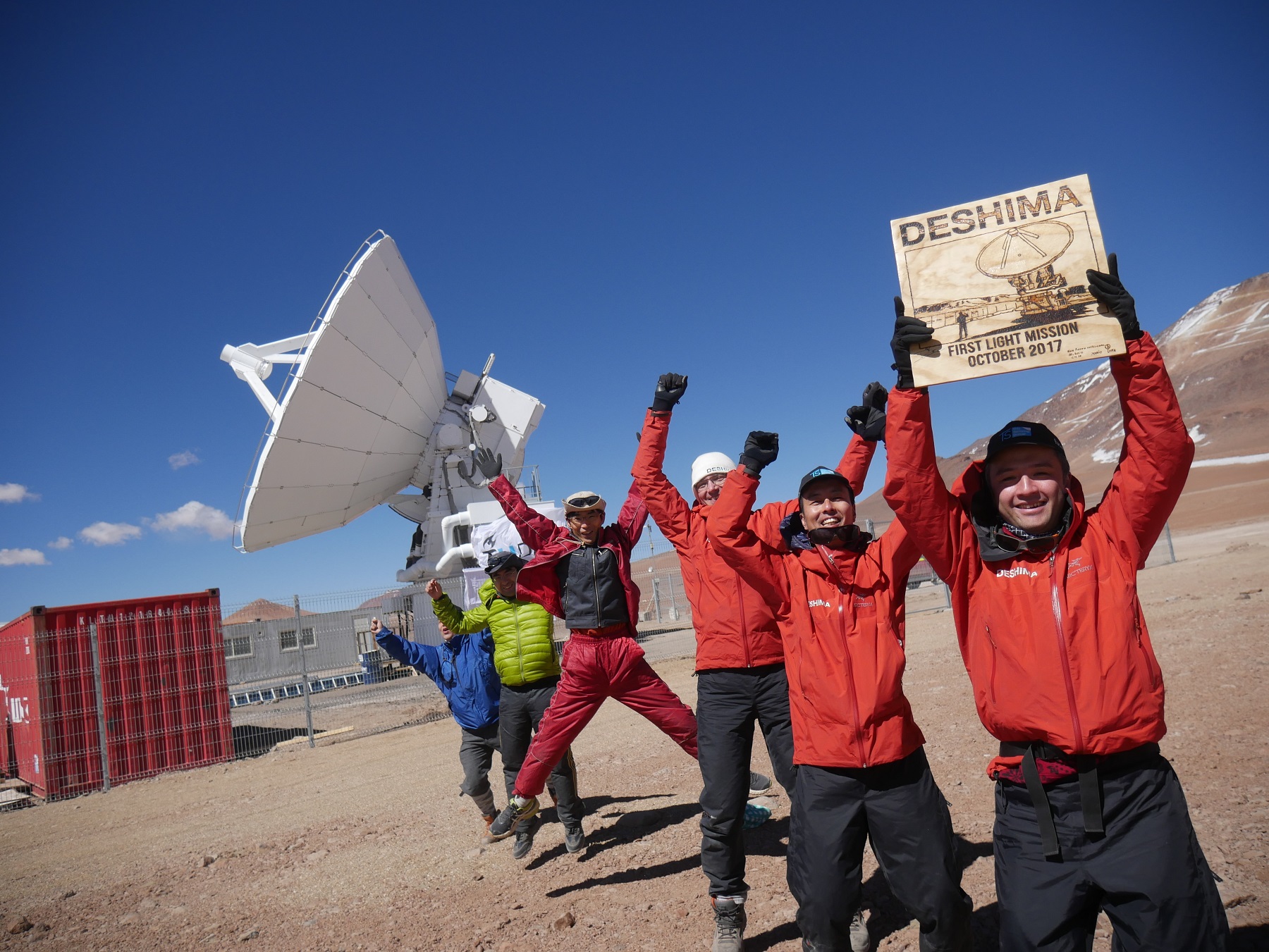TU Delft Astronomer and physicist Akira Endo worked on a chip that measures far-infrared light to ‘determine distances to galaxies that were hitherto hidden behind dust’.
Akira Endo (first in line) “It is quite special that we develop our own instruments and do our own astronomical science.” (Photo: Sven Peetoom)
At the core of the Dutch-Japanese made Deshima instrument is a chip the size of a two-euro coin. Dr Akira Endo (Faculty of EEMCS and Faculty of Applied Sciences) led the interdisciplinary team of researchers from TU Delft, the Netherlands Institute for Space Research (SRON), and Leiden University in developing this chip. The ultimate goal: mapping the galaxies in the universe.
Mapping the universe has proven to be a tough nut to crack because the brightness of stars or galaxies says little about their age. Astronomers bypass this problem by measuring the Doppler effect of light. The redder the light, the higher the speed, the further the galaxy. Unfortunately, the redshift of many galaxies in the early universe cannot be measured with visible light because starlight is shaded by dust clouds surrounding these galaxies. Measuring the redshift of these galaxies requires observations in far-infrared.
Focusing on Mars, Saturn and galaxy VV114
The superconducting detector that Endo’s team developed to detect far-infrared was tested at the end of 2017 on the Japanese ASTE telescope in North Chile. The first tests with the telescope, the so-called first light, were promising. The astronomers first focused the telescope-with-chip on Mars, Saturn and a number of well-known stars and galaxies. When they saw the expected slope in the graph without significant problems, the researchers aimed the telescope at the well-known distant galaxy VV114 and saw the predicted redshift. The results were published earlier this month in the journal Nature Astronomy.
Delta spoke to Akira Endo.
You came to TU Delft as a postdoc, obtained a Veni grant to develop a detector to study the evolution of the early universe, and now you not only developed the instrument with your colleagues, but also used it to carry out measurements. It seems you combine two specialities: the building of instruments and actual astronomy. How special is that?
“I guess it is quite special that we develop our own instruments and do our own astronomical science. Radio astronomy was started by very enthusiastic electrical engineers who pointed their gear towards the sky and noticed that there was something out there. But nowadays people need to be very specialised. You are either an instrument scientist, an astronomer or a physicist. In the Deshima project, we took another approach with a high level of interdisciplinary integration.”
Why did you come to Delft 10 years ago?
“TU Delft appeared to me to be one of the few places in the world where physicists developed new technology to detect astronomical light from scratch. In Japan, it was exciting for me to work on technology with cutting edge performance, but at the same time the technology was based on concepts that had been around for decades. I wanted to work on concepts nobody had envisaged before. I needed that for my future career as an experimental astronomer. I was 27 when I got a PhD in Tokyo and when I met Prof. Teun Klapwijk of TU Delft and Prof. Jochem Baselmans of SRON. At that time they had started working on microwave kinetic inductance detectors (MKIDs), a new type of astronomical chips that are now used in Deshima.”
In a TU Delft press release, you say that you are amazed that all the tests went according to plan.
“When you are testing a new instrument based on conventional technology at the telescope, and all goes to plan, you may consider yourself lucky, let alone if you are testing a completely new type of technology as we did. Our test campaign went extremely smoothly. We had everything running ahead of time and even had to call in astronomers from Japan in advance to help us perform the first measurements.”
What’s your goal now, to figure out how the universe started and expanded?
“The goal of our mission is indeed to study the bigger picture. How were galaxies born and how did they evolve, including our own galaxy? For that, you have to know their mutual distances and age. We will upgrade our chip, and next year we will go back to Chile with Deshima 2.0. It must perform more than a hundred times better than Deshima 1.0. We plan to measure one galaxy every night and come back with a handful of dusty star forming galaxies with redshift identifications.”
Everything on one single chip
The superconducting detector Endo and his colleagues developed is called an integrated superconducting spectrometer (ISS). The ISS is based on microwave kinetic inductance detectors (MKIDs) technology and performs antenna-coupling, frequency-separation and photodetection on a single chip.
Endo et al., “Wideband on-chip terahertz spectrometer based on a superconducting filterbank”
Journal of Astronomical Telescopes, Instruments, and Systems, 5(3), 035004 (2019).
https://doi.org/10.1117/1.JATIS.5.3.035004
Endo et al., “First light demonstration of the integrated superconducting spectrometer”
Nature Astronomy 2019
https://doi.org/10.1038/s41550-019-0850-8
Do you have a question or comment about this article?
tomas.vandijk@tudelft.nl


Comments are closed.